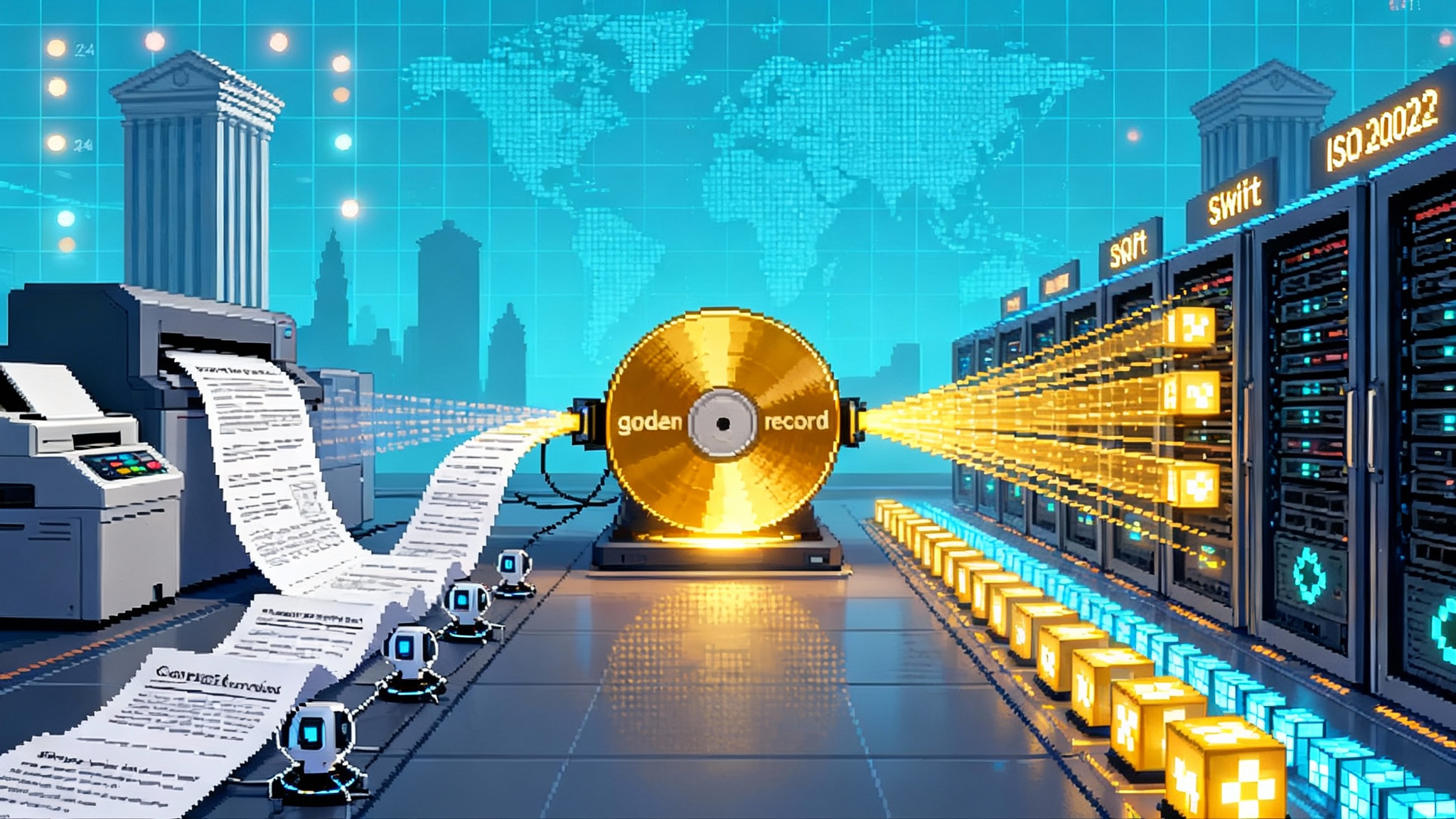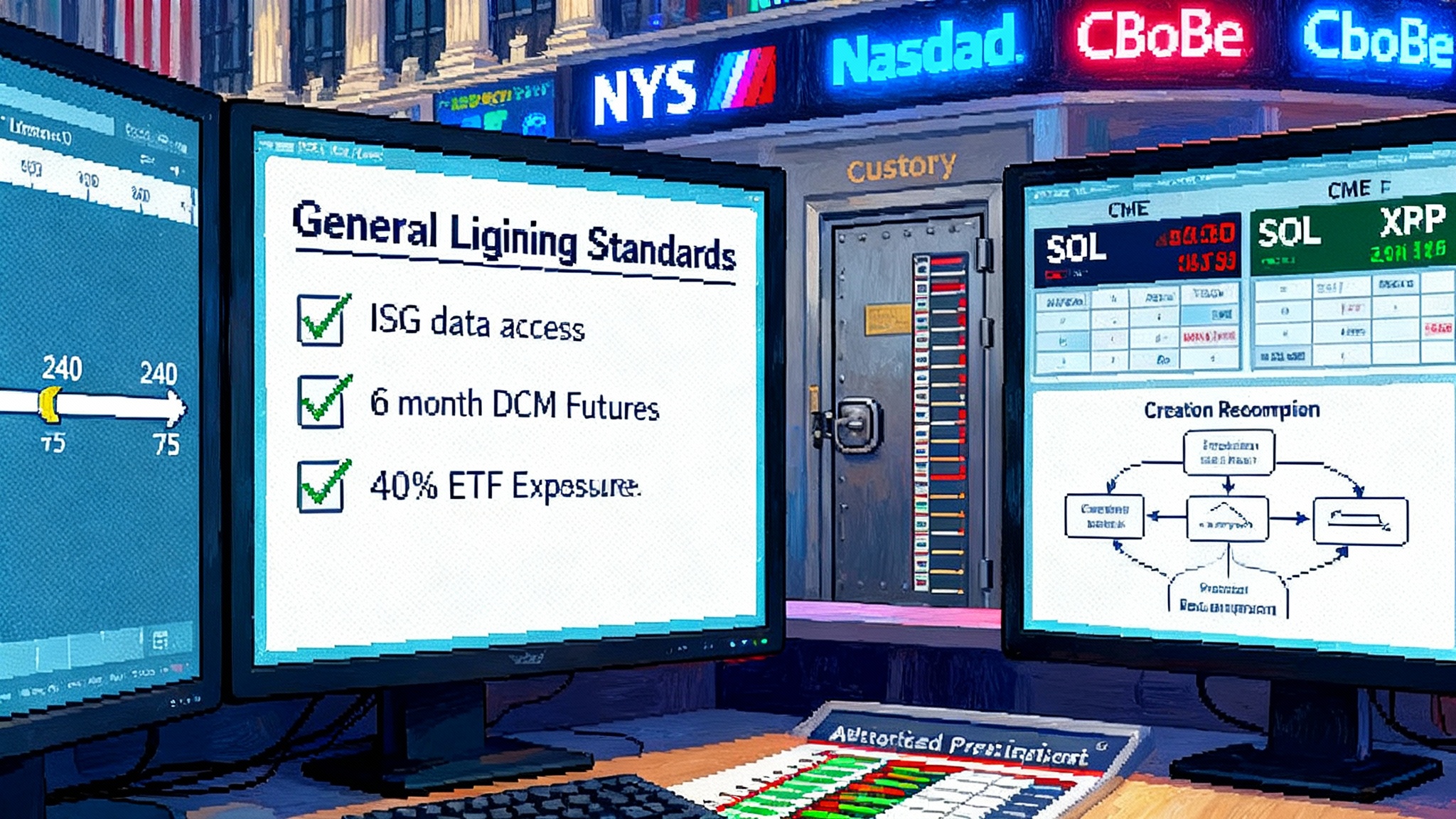Sibos 2025: Corporate Actions Get an Onchain Golden Record
At Sibos 2025 in Frankfurt, a production workflow from Swift, DTCC and Chainlink standardizes corporate actions into on chain golden records mapped to ISO 20022. The result is faster timelines, fewer breaks and a clear path to tokenized funds at scale.

The quiet breakthrough back offices needed
If you want to see where tokenized finance becomes real, do not look at flashy trading apps. Look at the back office. At Sibos 2025 in Frankfurt, Chainlink, Swift and DTCC revealed a production workflow with 24 major financial institutions that takes the chaos of corporate actions and standardizes it into on chain golden records, then pipes those records into the industry’s existing ISO 20022 messages and Swift rails. That means dividends, splits, rights issues and mergers can be represented as a single, verified source of truth that both blockchains and legacy systems can read the same way. The initiative targets a corporate actions problem that has long cost the industry tens of billions each year. Recent progress putting blue chips on chain in Europe shows how cleaner plumbing can unlock real products.
Why corporate actions, and why now
Corporate actions are the asset servicing events that update the reality of a security over its life. A split increases shares outstanding. A dividend distributes cash. A merger replaces one security with another. Today, these events originate in many formats and languages, get summarized by agents and intermediaries, and then ripple across custodians, market infrastructures and asset managers. Manual keying, mismatched templates and timing errors create breaks and rework. Industry estimates peg processing costs near 58 billion dollars annually, with automation still too low for comfort.
The new workflow in plain English
Think of corporate actions processing like building a bridge over a river that shifts with the seasons. You need a firm foundation on both shores and a span that holds as flows change.
- Source: Issuers and agents publish announcements in human language documents, sometimes with attachments or localized disclosures.
- Extract: Multiple language models read those documents and pull out structured fields like record date, ex date, cash per share, options and election deadlines.
- Attest: New roles called data contributors and data attestors validate and enrich the extracted fields, checking the measurements against the plans.
- Publish: Once confirmed, the data is turned into ISO 20022 compliant messages and also published as an on chain golden record. The same facts then flow to both legacy systems and smart contracts.
Under the hood, an orchestration layer runs model consensus, produces ISO 20022 payloads that travel over the Swift network and publishes the confirmed record across the relevant public or private chains so every connected contract sees the same truth. What makes this credible is the fit with existing standards. ISO 20022 already defines corporate actions messages such as seev.031 for notifications and seev.036 for movement confirmations. Mapping the golden record into those messages means asset servicers can consume trusted on chain data without replacing their systems.
A concrete example: an instant split and a programmable dividend
Imagine a large cap company declares a two for one split plus a small cash dividend for shareholders of record next month. Here is how the new flow changes things:
- The issuer’s announcement lands in multiple markets and languages. Models extract the dates, factors and cash amounts. Attestors check them, including localized nuances.
- The confirmed golden record is published. Swift messages carry seev.031 notifications to custodians and brokers at the same time that smart contracts receive the record.
- Tokenized asset platforms update token metadata and holdings programmatically. Custodians update positions. Venues adjust tick sizes and quantities. Payment agents line up cash flows.
- On the pay date, the dividend triggers from the golden record, allocating cash per share to eligible wallets and accounts. If the event offers elections, investors submit instructions and receive a seev.036 confirmation while a contract commits the same outcome on chain.
Timelines collapse from days to minutes because every step is running off the same record. Custodians do not need to reconcile against an unstructured notice. Smart contracts do not need a custom adapter per issuer. Everyone reads the same structured facts, in sync.
Why it could unlock tokenized funds at scale
Tokenized funds are held back by a simple bottleneck. If the underlying fund data, events and entitlements are not machine actionable, everything else is stuck. DTCC’s Smart NAV pilot showed that distributing fund net asset values on chain can seed automation and tokenization use cases. See the DTCC Smart NAV pilot report for the pattern of publishing trusted data into both legacy and blockchain environments.
Sibos 2025 extends that logic to the full set of corporate actions. Once golden records flow into ISO 20022 messages and on chain contracts at the same time, managers can automate subscriptions, redemptions and entitlements with far less bespoke integration. In July 2025, the United States enacted the GENIUS Act, the first comprehensive framework for payment stablecoins. As we covered in GENIUS Act reshapes payouts, regulatory clarity reduces settlement risk for cash legs and makes programmable distributions more practical.
A second structural shift: Swift readies digital rails
Swift announced a blockchain based shared ledger to complement its messaging and APIs, enabling instant, always on settlement of regulated tokenized value. See the official update, Swift adds blockchain-based ledger. If Swift’s ledger handles 24 by 7 payments between banks and corporate action golden records flow over Swift messages and on chain at the same time, cash and entitlements can move on synchronized rails. That reduces off ledger breaks during busy cycles and turns the post announcement window into a programmable period where settlement logic is embedded into both cash and asset legs.
What to watch over the next 6 to 12 months
- Volume and coverage of golden records
- Daily and monthly counts published, plus percent of global event types covered beyond cash dividends and splits, including mergers, rights and reorganizations. Look for multilingual coverage and more complex events validated by attestors.
- ISO 20022 traffic tied to the new flow
- Evidence that seev.031 notifications and seev.036 confirmations from the workflow are consumed by custodians and brokers with fewer breaks and faster instruction windows. Vendors and market infrastructures should cite improved straight through processing rates.
- Time to final and error rates
- Median time from issuer announcement to confirmed golden record, rework rates when fields change after publication and declines in reconciliation tickets.
- Number of attestors and contributors
- Growth in named institutions performing data attestation, with service levels and change management published.
- Custodian and fund administrator integrations
- Public confirmations that golden records are consumed directly in asset servicing stacks, plus portal updates and client letters about improved cutoffs and real time status.
- Tokenized fund plumbing milestones
- Production use of Swift based subscription and redemption messaging and the first managers to publish a full entitlement calendar as on chain events.
- Swift ledger pilots moving beyond design
- Banks publishing pilot results that show round the clock interbank payments settling alongside securities events. Interoperability with existing rails is the key.
- DTCC’s AnnounceDirect path
- Progress toward standardizing upstream issuer sourcing to tighten inputs for the golden record flow.
How this differs from rollups and data availability layers
- Purpose: This workflow is not about building a new chain for faster execution. It creates a standard truth for events that all chains and legacy systems can use. Rollups and data availability layers scale throughput and reduce costs for transaction data but do not define what a dividend is or when a split takes effect.
- Integration point: Golden records plug into existing ISO 20022 seev messages and Swift. That alignment lets top custodians, administrators and managers adopt without ripping out systems.
- Interoperability model: Cross chain interoperability distributes confirmed records across public and private chains. Data availability layers ensure data remains accessible for proofs and reconstruction. Here, the problem is semantic agreement and synchronized delivery across old and new rails.
What changes for investors and operations teams
- Fewer missed entitlements: When the record date and conditions are represented once and synchronized across systems, the classic break where one system missed the cutoff should shrink.
- Faster elections and confirmations: If the event creates options, investors can submit instructions sooner and receive confirmations in near real time because the same golden record drives both the on chain action and the seev.036 confirmation.
- Programmable compliance: Golden records can carry eligibility and withholding logic that operational systems can enforce consistently, making cross border distributions less error prone.
- Clearer audit trails: With attested data on chain and mirrored into ISO messages, firms gain a stronger evidence chain for post event reviews.
Risks and open questions
- Liability and error handling: Attestor roles are new. Contracts must specify who is responsible for an error, how corrections propagate and how compensation is handled if investors are harmed by a faulty record.
- Model governance: Multiple models extract key fields. Firms will demand rigorous monitoring, versioning and bias checks, with the attestation layer consistently catching mistakes before publication.
- Vendor concentration: Over reliance on one orchestration stack is a risk. Mitigation looks like open specifications for the golden record schema, multiple attestors and documented fallbacks to traditional sourcing.
- Policy timelines: The GENIUS Act provides clarity for payment stablecoins, but rulemaking and compliance transitions will take time. Related market structure changes, such as generic rules for altcoin ETFs, will shape adoption.
- Upstream data quality: Standardizing issuer sourcing is essential. Without cleaner announcements, extraction and attestation layers will carry more load than they should.
What to do next
- For custodians and administrators: Map your corporate actions workflows to ISO 20022 seev message variants. Identify where golden records can replace manual keying and start with the highest volume event types.
- For asset managers: Pick a pilot fund with frequent cash events. Publish an entitlement calendar as golden records and consume the same data on chain for any tokenized share classes. Use Swift messaging to keep existing clients in the loop while contracts automate payouts.
- For banks and payment providers: Track Swift ledger pilots and identify where always on interbank payments can reduce corporate actions liquidity buffers. Build a thin abstraction so treasury can route between the ledger and current rails based on cutoffs and risk.
- For product and risk teams: Define error budgets and compensation rules for attested data. Decide who approves a correction and how quickly downstream systems must reconcile. Write it down before volumes grow.
The bottom line
Sibos 2025’s headline was not a new chain or a speculative token. It was a data plumbing upgrade that aligns the world’s asset servicing stack with the programmability of blockchains. Golden records for corporate actions, delivered as ISO 20022 messages and on chain facts, remove friction at the exact place where tokenized finance breaks. Pair that with Swift’s move toward a shared ledger for always on payments, and you get synchronized cash and entitlements. That combination can turn pilot scale tokenized funds into production products and make programmable dividends and instant splits routine rather than newsworthy. The best part is that it happens inside the systems people already use.








